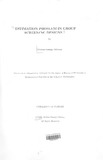| dc.description.abstract | In many situations units of some sort are to be tested perhaps to label them as defective ( non-satisfactory) or non-defective ( satisfactory). Often testing the units one by one is inefficient especially when they are cheap to obtain relative to the cost of the test. In such cases it is often preferable to form groups of units and test all units in a group simultaneously. This is called' group testing' or 'group screening' in statistical literature.
This thesis considers estimation of the prevalence rate in a group screening design using two methods: maximum likelihood method and Bayesian method. Most of the work in group screening have concentrated on designs without errors. In this work we have undertaken a review of these works and extending them to the case with errors, which involves taking the accuracy of the screening or testing equipment into consideration.
It is shown that for small group sizes and large values of p and k, the bias is considerable while for low values of p and k, there is relatively little bias.and that the best design for a given experiment depends on the prevalence rate, tolerable mean square error, the sampling cost of an individual sample and the cost of performing a single test. We have also shown how Bayes methods can be incorporated in the group screening problem.
For low prevalence rate, we have shown that Bayes estimator outperforms the maximum likelihood estimator in terms of bias and mean square error. Also we have argued that interval estimates based on Bayes method may be more appropriate, as to avoid intervals extending outside the parameter space. By taking measurement errors into consideration, we have shown that by group testing we not only achieve a cost saving, but also an increase in the estimation accuracy.
For estimating infection rate in a population of organisms, when sample pools of unequal sizes are analyzed, we have suggested an iterative method of determining successive estimates of the infection rate,resulting in an estimator which can easily be evaluated and upgraded, using the average size of positive pools. | en_US |

